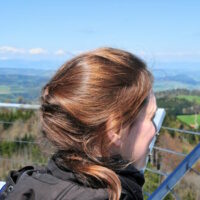Alpabzug Seewis im Praettigau 8 October 2016
-
Every year in the alps, farmers take their cows and/or goats up to graze on the high alpine pastures during the summer. In autumn, before the snow sets in, the farmers adorn their cows with flowers and big cowbells and descend with them in a procession back to their villages. In German-speaking Switzerland this is called the Alpabzug, and in the French-speaking area it is called the désalpe.
I went to the “Prättigauer Alp Spektakel” Alpabzug in Seewis im Prättigau during my recent trip to Switzerland. The Alpabzug was actually just one event of many in a 4-day alpine festival. On the day of the Alpabzug, there was also a village market selling local produce (mainly cheese!) and handicrafts, as well as food stalls and some large tents and indoor venues where you could have sit-down meals and drinks.
To get to Seewis, you catch a train to Grüsch, which is between Landquart and Klosters. From Grüsch there is a PostAuto bus to Seewis, a trip of 10 minutes that climbs about 300 metres in altitude along a winding road above Grüsch. On the day of the Alpabzug, there were also additional shuttle buses running frequently between Grüsch railway station and Seewis village. No cars were permitted to drive up to the village, but parking was available in Grüsch, and the shuttle bus also serviced the car-parking area.
I was travelling from Scuol, and had the option of arriving at Seewis at about 9:15 am or a bit after 11:00 am. As the Alpabzug was due to enter the village at 11:00 am, and I had read that there would be delays for people arriving in Grüsch after about 9.30 (due to the number of people to be transported from Grüsch up to the village), I opted for an early arrival and left chilly Scuol on the 7:41 train after a hasty breakfast, reaching Grüsch just after 9:00 am. Various people in traditional clothing boarded the train along the way, also headed for the Alpabzug.
There was a table set up in front of the station at Grüsch, where you could pay your admission for the Alp Spektakel (CHF 10). There wasn’t too much of a crowd at the station, and I was able to get onto one of the buses up to Seewis straight away. The bus dropped us on the edge of the village, and it was just a matter of following the crowd uphill to find the centre of the village, where the market was under way.
I filled in the next hour or so by strolling through the market and around the village, during which time I came across a map showing the route the Alpabzug would take coming down the mountain and then through the village. As the village streets were narrow, and the crowd was building up, I thought it might be better to walk out of the village a little way, hoping I would get a better vantage point without too many people obstructing my view. This turned out to be a good idea, and a steady stream of people walked much further up the mountain as well.
The Alpabzug wasn’t a continuous procession, but started off with a cart pulled by a decorated cow, and followed by some small girls with floral head-dresses, carrying baskets of cheese that were also decorated with flowers.
After a few minutes, bells ringing rhythmically in unison could be heard from higher up the mountain, and eventually a group of 8 men came into view, walking two-abreast and each carrying two huge bells suspended from curved wooden beams across their shoulders.
A short while after the bell ringers came some goats, with red scarves and small bells around their necks. They were quite hilarious, being totally incapable of walking in anything resembling a straight line, and sometimes turning around and heading in the wrong direction. Some of them ran down the embankment at the side of the road, before being chased back up to re-join the procession! A small boy of about 6 years old provided some wonderful entertainment, running here and there with his wooden staff, helping to round up the goats, with a call that sounded like “höa, höa”.
Then came one group of cows after another, with their big bells and beautiful floral head-dresses, accompanied by the farming families – men, women and children of all ages, many wearing traditional embroidered blue shirts, and most carrying a wooden staff.
The whole parade took about 20 minutes, and after the last cows had passed, everyone headed back into the village to have some lunch. One of the stalls was serving raclette, so I took this opportunity to try it for the first time!
When I eventually decided to walk down to the village bus stop to catch a bus back to Grüsch railway station, lots of other people had the same idea, and I had to wait for the fourth bus before I managed to get aboard. However, they were running frequently, so I didn’t have to wait more than about 15 minutes.
This was a community event drawing a large crowd into a small village. I was impressed with how well it was organised, including transport, food and toilet facilities. Luckily the weather co-operated as well. It was chilly, sometimes sunny, sometimes threateningly cloudy, but dry all day.
This day was definitely one of the highlights of my trip! If anyone is interested in seeing the Alpabzug next year, it will be on Saturday 7 October 2017. (This is one of the few Alpabzüge that set a firm date so far in advance, which is very helpful in enabling you to incorporate it into your itinerary). Some photos are attached.
Alpenrose
- The thread ‘Alpabzug Seewis im Praettigau 8 October 2016’ is closed to new replies.

